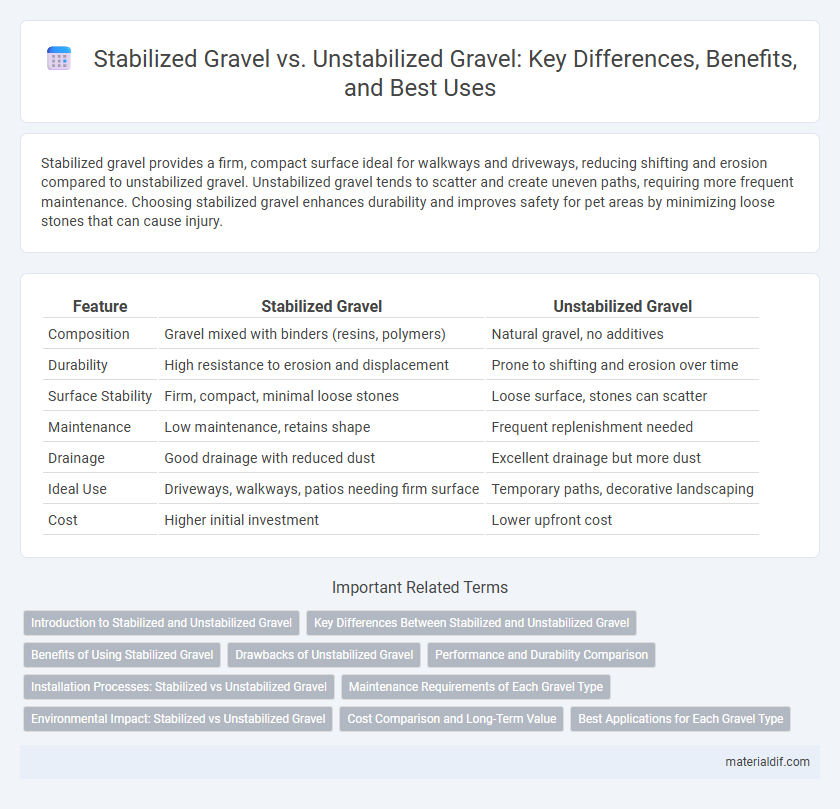Stabilized gravel provides a firm, compact surface ideal for walkways and driveways, reducing shifting and erosion compared to unstabilized gravel. Unstabilized gravel tends to scatter and create uneven paths, requiring more frequent maintenance. Choosing stabilized gravel enhances durability and improves safety for pet areas by minimizing loose stones that can cause injury.
Table of Comparison
| Feature | Stabilized Gravel | Unstabilized Gravel |
|---|---|---|
| Composition | Gravel mixed with binders (resins, polymers) | Natural gravel, no additives |
| Durability | High resistance to erosion and displacement | Prone to shifting and erosion over time |
| Surface Stability | Firm, compact, minimal loose stones | Loose surface, stones can scatter |
| Maintenance | Low maintenance, retains shape | Frequent replenishment needed |
| Drainage | Good drainage with reduced dust | Excellent drainage but more dust |
| Ideal Use | Driveways, walkways, patios needing firm surface | Temporary paths, decorative landscaping |
| Cost | Higher initial investment | Lower upfront cost |
Introduction to Stabilized and Unstabilized Gravel
Stabilized gravel consists of aggregate particles bound together by a binder such as resin, asphalt, or a chemical stabilizer, providing enhanced durability, reduced dust, and increased load-bearing capacity for pathways and driveways. Unstabilized gravel, composed solely of loose, untreated aggregate, offers greater permeability but is prone to displacement, dust generation, and frequent maintenance. Choosing between stabilized and unstabilized gravel depends on project requirements for stability, aesthetics, drainage, and maintenance frequency.
Key Differences Between Stabilized and Unstabilized Gravel
Stabilized gravel incorporates binding agents such as polymers or cement to improve compaction, durability, and resistance to erosion, making it ideal for driveways and pathways requiring low maintenance. Unstabilized gravel lacks additives, resulting in looser material that can shift under traffic and weather, requiring more frequent replenishment and grading. The key difference lies in stability and longevity, with stabilized gravel offering enhanced structural integrity and reduced dust compared to the more permeable and flexible unstabilized variety.
Benefits of Using Stabilized Gravel
Stabilized gravel offers superior durability and erosion control compared to unstabilized gravel, making it ideal for heavy traffic areas and driveways. It reduces dust and washouts by binding the particles together, enhancing surface stability and longevity. Using stabilized gravel also minimizes maintenance costs and improves water drainage efficiency on pathways and landscaping projects.
Drawbacks of Unstabilized Gravel
Unstabilized gravel tends to shift and disperse under heavy traffic or harsh weather conditions, leading to uneven surfaces and frequent maintenance needs. It often causes dust generation and erosion, which can result in poor drainage and environmental concerns. Without binding agents, unstabilized gravel lacks durability and stability, making it less suitable for high-load or long-term applications.
Performance and Durability Comparison
Stabilized gravel offers superior performance and durability compared to unstabilized gravel by incorporating binders or additives that enhance compaction and reduce erosion. The improved cohesion of stabilized gravel results in a more stable surface, resisting displacement under heavy traffic and adverse weather conditions. Unstabilized gravel tends to degrade faster due to loose particle movement, requiring more frequent maintenance and replenishment.
Installation Processes: Stabilized vs Unstabilized Gravel
Stabilized gravel involves mixing binders such as resin, cement, or polymers to create a compact, durable surface that resists erosion and displacement during installation. Unstabilized gravel is laid directly over a prepared sub-base without binders, relying on compaction and grading for stability but often requiring more frequent maintenance due to loose stones. The installation of stabilized gravel typically demands specialized equipment and curing time, while unstabilized gravel offers quicker, more flexible placement but with less long-term structural integrity.
Maintenance Requirements of Each Gravel Type
Stabilized gravel requires less frequent maintenance due to its binding agents that reduce erosion and displacement, resulting in a more durable surface. Unstabilized gravel demands regular raking, replenishing, and compaction to prevent rutting, dust, and spreading. Proper maintenance schedules for stabilized gravel can extend its lifespan significantly compared to the more labor-intensive upkeep of unstabilized gravel.
Environmental Impact: Stabilized vs Unstabilized Gravel
Stabilized gravel significantly reduces soil erosion and sediment runoff compared to unstabilized gravel by maintaining a solid, bonded surface that resists displacement during heavy rainfall. Unstabilized gravel allows more water permeability, which can lead to increased sediment transport and potential contamination of nearby water bodies. Choosing stabilized gravel minimizes environmental degradation by preserving soil integrity and reducing the need for frequent maintenance and gravel replacement.
Cost Comparison and Long-Term Value
Stabilized gravel typically costs 20-30% more upfront than unstabilized gravel due to the added binding materials that enhance durability and reduce erosion. Over time, stabilized gravel requires less maintenance and fewer repairs, delivering greater long-term value by maintaining surface integrity and preventing costly replacements. Unstabilized gravel may seem economical initially but often incurs higher expenses from frequent replenishing and grading, reducing overall cost efficiency.
Best Applications for Each Gravel Type
Stabilized gravel, enhanced with binders or additives, is ideal for high-traffic areas like driveways, walkways, and commercial paths where durability and reduced maintenance are crucial. Unstabilized gravel suits landscaping, garden paths, and decorative applications, offering natural drainage and a cost-effective, flexible solution. Choosing between the two depends on project demands for structural integrity versus aesthetic versatility.
Stabilized Gravel vs Unstabilized Gravel Infographic

 materialdif.com
materialdif.com